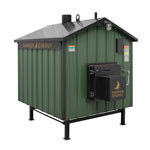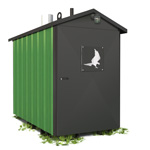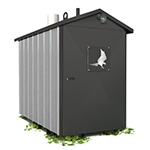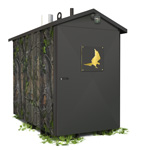What's an outdoor wood-burning hydronic furnace?
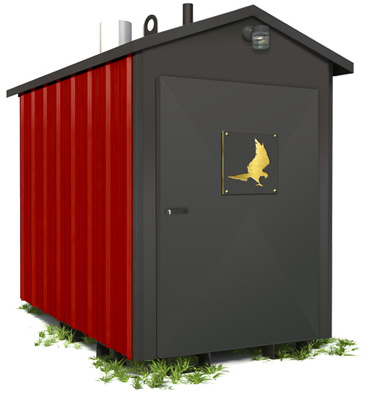
It all starts with wood. Wood is the most practical of all renewable energy sources. It is available during snow and sun, light and dark, hot and cold. For those living off of the natural gas pipeline, wood is also the cheapest energy source available.
Compared to other wood-burning options, an outdoor wood-burning furnace is a great option. Hardwood is much cheaper and more plentiful than wood pellets, and outdoor furnaces don't have a lot of the drawbacks that indoor stoves do.
For example, with an indoor stove you have smoke, ash, bugs, dirt, and wood sitting in your house! There is also a real danger of house fires and carbon monoxide poisoning. Outdoor furnaces eliminate those problems.
Alright, so how does it work? Basically, wood is burned in a firebox that is completely surrounded by a chamber of water called the “water jacket”. As the fire burns, the water is heated. The heated water in the water jacket is continuously pumped to your home or building 24 hours per day. The water is pumped through well-insulated pipes which are buried about two feet underground between the outdoor furnace and your building. The water is pumped in a continuous loop - from the outdoor furnace through the underground pipe to the house where heat is exchanged, and then back to the furnace. (see illustration below) Additional pumps can be added to provide heat to other buildings.
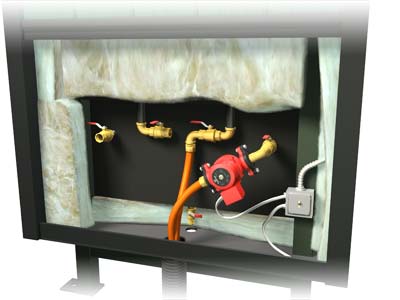
Once the water is heated to 180 degrees F, a blower fan that is feeding air to the fire is automatically turned off and the damper is closed. This starves the fire of oxygen and saves wood. Without oxygen, the wood will smolder until the water drops to 160 degrees at which temperature the blower fan automatically turns on again. Therefore, the water in the water jacket is constantly maintained between 160 and 180 degrees Fahrenheit without any effort on your part. All you do is add wood when needed. Many homes only require that you add wood one time a day.
Use With Forced Air Systems
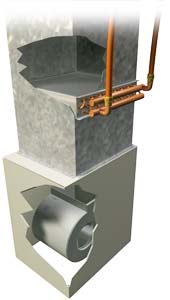
It is important to note that our system will interface with your existing heating system – even if you have a forced air heating system. Many people have the misperception that they cannot use our system to heat their home unless they have baseboard heat. Most of our customers have a forced air system that blows warm air into their home through registers. Our system hooks into a forced air system through the use of a heat exchanger that looks like an auto radiator. This device is installed in your plenum – the box above your furnace where the warm air is blowing. The heated water circulates through this device and when the furnace blower fan turns on, nice warm air is delivered to your entire home or building. Your existing thermostat is set at a low temperature as a backup so you do not burn any gas or heating fuel. A new thermostat is installed that is set at a nice warm temperature, and this thermostat controls the blower fan only on your existing furnace. (see illustration above)
Use With Hot Water Systems
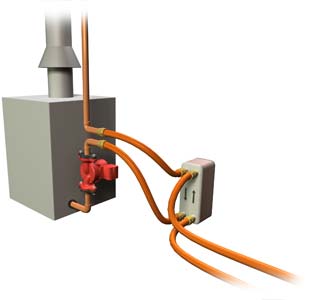
Indoor boilers that provide heat through baseboards are simple to hook into. We provide a water-to-water heat exchanger that looks like a large brick. The water from the outdoor furnace flows through one side of the heat exchanger and the water from the indoor boiler flows through the other side. (see illustration above) Although the water does not mix, heat is transferred from the outdoor system to the indoor one. It is important that the water does not mix since the outdoor system is not pressurized and the indoor boiler is pressurized - and must not be depressurized. This water-to-water heat exchanger very easily transfers the heat to your home while keeping your entire system safe.
Heat Your Shop or Barn
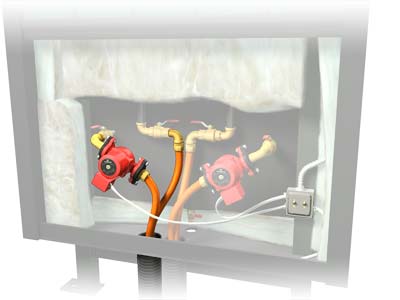
You can heat your pole barn, workshop or other building very easily. The dual connections at the back of the furnace allow you to send heat to more than one building (see illustration above).
If your other building does not have an existing heating system to hook into, you can use a unit heater. (see illustration below). These heaters consist of a blower fan and a heat exchanger and they are controlled by a thermostat so you control the heat. Please call us for proper sizing.
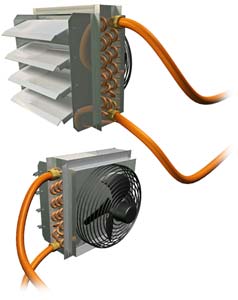
Heat Your Domestic Hot Water
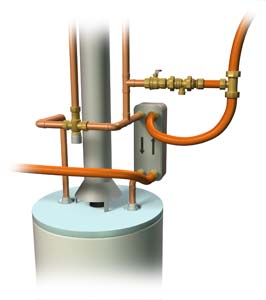
Your hot water heater will never burn any more fuel or use any more electricity! The domestic hot water kit works much like the indoor boiler system using a plate heat exchanger to pre-heat the water going into your hot water tank. Water going out of your hot water tank passes through a mixing valve that keeps the water at a safe temperature. (see illustration above). Warren’s wife and five daughters use a lot of hot water; he says “No Problem, I’ll just put another log on the fire”.
Hawken furnaces also can provide heat for many other applications including the following:
- In Floor Radiant Heating
- Pools and Hot Tubs
- Greenhouses
- Commercial Buildings
- Snow Melt Systems
We have detailed installation diagrams on each of these applications that show how simple and effective they are. Please contact your Authorized Hawken Dealer with any questions you may have regarding how Hawken furnaces can provide all the heat you desire at the lowest cost!
To request FREE brochures or a Comparison Report, give us a buzz... BUZZ
